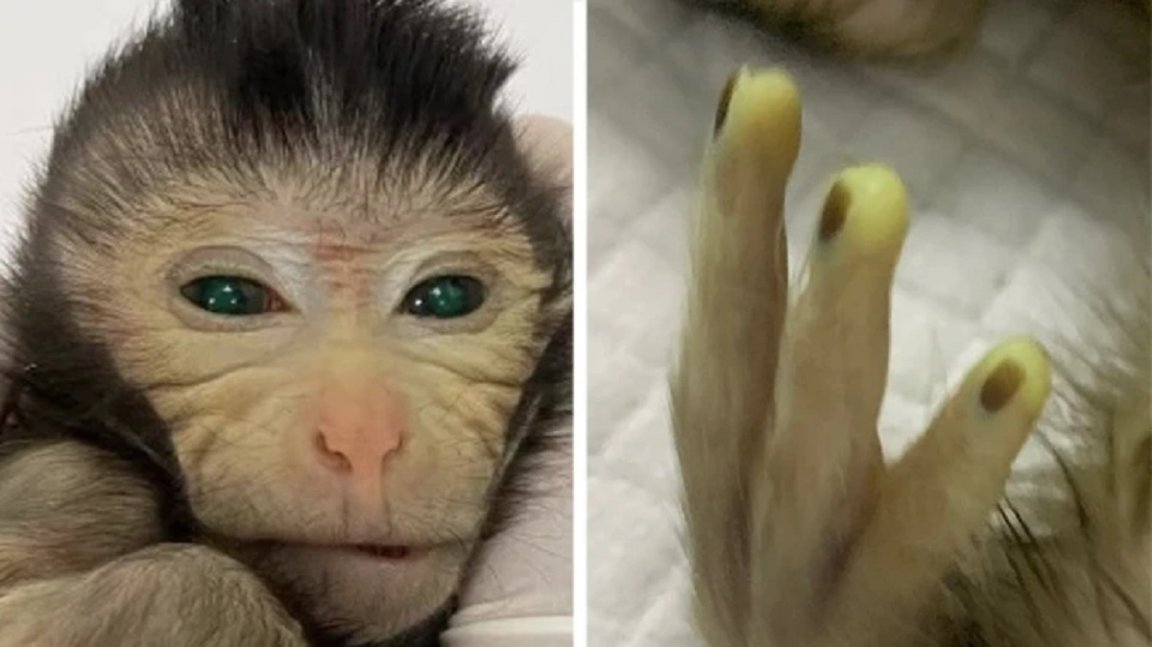
Behold! Scientists in China have announced the birth of a glowing green monkey.
Yes, it’s real. As The Independent reports, the lab-born primate has made history as the world’s first live-born “chimeric” monkey. A chimera, as the report explains, is an animal with more than two sets of DNA; in this case, the long-tailed macaque was created by combining two genetically distinct embryos of the same species.
And by all accounts, this little monkey — which, sadly, was euthanized by researchers after ten days — was a strange fellow indeed. According to the researchers’ proof-of-concept study, published Thursday in the journal Cell, the macaque had a glowing green face and fingertips, in addition to fluorescent green eyes.
The researchers aren’t just trying to build a chimeric primate for the hell of it. As the Independent notes, scientists often use chimeric mice and rats in lab settings as a means of studying embryonic development, as well as examining disease progression in living organs and tissues. Mice and rats, however, aren’t nearly as genetically similar to humans as our primate cousins are, meaning that the successful engineering of chimeric monkeys could offer humanity much more accurate — and thus, hopefully, more fruitful — means of cellular study and disease modeling. (Sorry, it’s a little sad, we know.)
“Mice don’t reproduce many aspects of human disease for their physiology being too different from ours,” senior study author Zhen Liu, a researcher at the Chinese Academy of Sciences, told CNN. “In contrast, human and monkey are close evolutionary, so human diseases can be more faithfully modeled in monkeys.”
To create the monkey, scientists took stem cells from a seven-day-old embryo — the donor embryo — and added them to another, slightly younger embryo. These embryos were then implanted into several female macaques, leading to 12 pregnancies in total. Of those twelve, six infants were born — and one, the lil’ guy in question, was born alive.
Though the monkey didn’t live for long, its successful birth represents a notable stride in genetic modification research. As ScienceAlert notes, in past attempts to create chimeric primates, the donor DNA was deeply underrepresented in the offspring’s body tissues. But this time, according to the study, donor DNA was found in 26 different types of body tissue — and in rates varying from 21 to an astonishing 92 percent, no less. These are significant increases from previous trials, and an exciting turning of the tides for genetic researchers.
Scientists seem particularly thrilled about a large aggregation of donor cells found in the primate’s brain tissue. As study coauthor Miguel Esteban, principal investigator at the Guangzhou Institute of Biomedicine and Health at the Chinese Academy of Sciences, told CNN, this finding suggests that chimeric macaques could one day be useful for “modeling neurodegenerative diseases.”
By the way, if you’re wondering why this perfect little goblin was green, it was on purpose. When the scientists combined the embryos, they added a green fluorescent protein to the donor cells — that way, they could more easily track where some of that DNA was disseminating. This in mind, the fact that it was visible from the outside-in is pretty wild.
As fascinating as this breakthrough is, however, it’s important to remember that the monkey wasn’t born healthy; if it was, researchers wouldn’t have had to euthanize the guy after only ten days. So, there’s still a long way to go in the journey toward the first truly viable chimera primate.
Regardless, this study may well be seen as a landmark trial — or at least, a trial that opens the door to future breakthroughs. RIP, little freak. You made history!
More on genetic research: Doctors Testing Gene Therapy to Cure a Type of Deafness